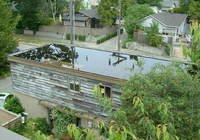Flat Roof Membranes
/March 2018
In the Pacific NW, there are many different types of roofing materials that can be applied onto a flat roof of a home or commercial building. These include metal, silicone spray foam, EPDM rubber, single ply, built up, and bitumen based. Bitumen is asphalt or coal tar based material. Single ply, built up roofing (BUR) and torch down roofing are the most common types we see installed in the Pacific NW. So what are the general differences between the common roofing types?
Single Ply Membrane Roofing:
There are three kinds of single ply roofing: 1) polyvinyl chloride (PVC), 2) thermoplastic polyolefin (TPO) and 3) ethylene propylene diene monomer (EPDM). Single ply membranes come in thicknesses between 40 mil and 80 mil, depending on manufacturer and type. Single ply can be mechanically or adhesively attached to the underlying substrates. PVC and TPO seams and laps are hot air welded or chemically bonded.
- PVC and TPO membranes– are installed in rows of 6’ or wider depending on the manufacturer’s material widths. Materials are durable, provide energy saving benefits on cooling days due to their reflectance abilities and are repairable without open flames. Since the membrane is only a single layer, damage to the roofing or a poor weld may readily allow water under the roofing.
Installation costs vary by site conditions, roofing contractor, manufacturer and material type and thickness. Generally, a square foot allowance cost for labor and material may be $9 to $10 for PVC’s and $7 to $8 for TPO’s.
- EPDM is a durable synthetic rubber roofing membrane derived primarily from oil and natural gas. EPDM is available in black and white and can be purchased in widths of 7.5 to 50 feet. EPDM can be installed using roofing adhesive, mechanically fastened or ballasted with gravel or rocks to hold it into place on the rooftop. Seams are sealed with liquid adhesive or formulated tapes.
Installation costs are generally $7 to $8 per square foot.
- Built Up Roofing - BUR – is durable and can take abuse from heavy foot traffic. The system is built up from multiple layers of ply sheets using hot asphalt to bond each layer together. Over the top layer a reflective coating can be applied for energy conservation by reflecting the sun’s rays. A multiple layered roofing system can offer peace of mind due to its many layers of roofing. There is redundancy in layering for protection against punctures from falling branches, impacts or sharp objects and failed seams or laps.
Installation costs are generally $7 to $8 per square foot.
Torched Down systems
- These systems consist of two to three layers of modified bitumen sheets. Each layer is flame torched down to the surface below. Like BUR, the torch work must be performed by a skilled roofer familiar with proper melting of the bitumen within the sheet layers to achieve proper melt, flow and adhesion to create a single system. The multiple layers create a durable system resistant to punctures and failures. A granulated cap sheet can be applied to add durability and protection of the underlying layers and from solar damage. Rejuvenating the roofing can be accomplished by adding another layer of torch down roofing over the existing system.
Installation costs are about $6 to $8 per square foot.
Regardless of the type of roofing or extent of the project, CDR recommends that two or more bids be obtained for the work and contracts be in writing and reviewed by an attorney before signing. Additionally, CDR recommends that manufacturer and installation warranties be researched and inspection protocols be followed during and after installation to maximize the life and warranty of the roof system.
